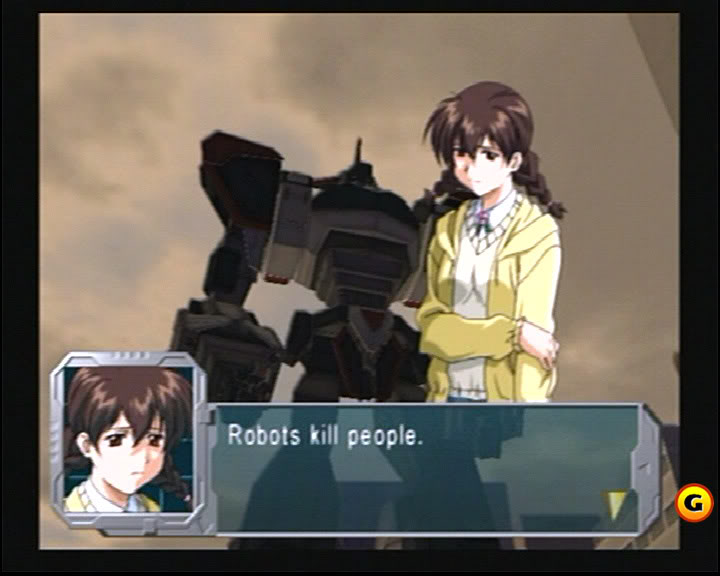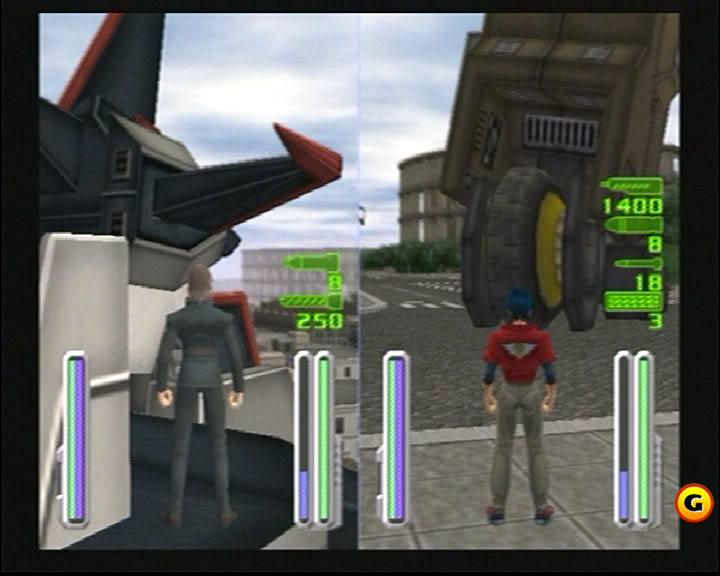This post has not been edited by the GamesBeat staff. Opinions by GamesBeat community writers do not necessarily reflect those of the staff.
Robot Alchemic Drive, or R.A.D, is a title that inspires confusion and strange looks in gamers everywhere. You probably have not heard of it, more than likely have never played it — but the blessed few who have will swear by it.
 R.A.D (known as "Gigantic Drive" in Japan) was produced for the Playstation 2 on November 4th 2002 in the U.S. by Enix, before they were absorbed to create the RPG spewing monolith now known as Square-Enix. Back in '02 Enix was known as the Dragon Warrior guys, who also had some underground hits in the Star Ocean and Valkyrie Profile games. R.A.D was in no way an RPG, but a slow paced and methodical action game involving giant robots!
R.A.D (known as "Gigantic Drive" in Japan) was produced for the Playstation 2 on November 4th 2002 in the U.S. by Enix, before they were absorbed to create the RPG spewing monolith now known as Square-Enix. Back in '02 Enix was known as the Dragon Warrior guys, who also had some underground hits in the Star Ocean and Valkyrie Profile games. R.A.D was in no way an RPG, but a slow paced and methodical action game involving giant robots!
Wait, Stop! Don't go anywhere! Let me explain!
See, the crazy thing about R.A.D is that it is one of the few games to utilize the second person almost through the entire game. First person games have you viewing the action through your character's point of view, and a third person game would have you view the action from outside your character with some kind of crazy invisible camera. A second person game would probably mean you view the action from another characters point of view that is not the one you control.
In R.A.D you play as one of three Japanese teenagers who have come into ownership of a fifteen story tall robot, as the story hilariously explains. Your character commands these robots with a device that looks suspiciously like a PS2 controller, and that is where the interesting bit comes in…
A typical mission has a big scary monster or two attacking a city, and you are charged with defending it with your own personal iron giant. To do this (and this is where the game starts to fuck with your head) you have to position your anime stereotype into a position where they can see both the robot you control and the enemy monstrosity, and then you hit the select button to jump into a view from their perspective. This means that if the fight moves behind a skyscraper you have to break control of your robot so you can move the easily breakable human into a position that lets you view the fight once again. One strategy is to sit your character on top of the robot's head, but the problem with that is if you got knocked over during the fight you will both take damage and then have to find another perspective in a hurry.
The controls deserve a mention as well because of how complex and unique they are. For example, in order to make your metal man do something as simple as walking, you need to press L1 for the left foot and R1 for the right foot. Left foot, right foot, left foot, right foot… If you want to walk backwards, it is L2 and then R2 and repeat. If you need to turn left you hold down L1 and L2 or R1 and R2 for right. Sound complicated? Well, let's just say that every button on the controller has an important purpose. You will probably start off playing with the instruction manual in your lap.
R.A.D also invented the punching system that was later used in the Fight Night series, where different types of punches are determined by analog stick movements — which was really revolutionary for the time. I could go into greater detail, but this article would probably be unnecessarily long as a result.
 Anyway, once you get the controls down you will be punching and smashing, shooting cannons and lasers, and occasionally [i]even[/i] transforming in order to pummel the other machine or Godzilla knockoff into submission. Depending on how much of the city you manage to salvage from destruction you get money which can be used to upgrade you or your meganite (the giant robot you control).
Anyway, once you get the controls down you will be punching and smashing, shooting cannons and lasers, and occasionally [i]even[/i] transforming in order to pummel the other machine or Godzilla knockoff into submission. Depending on how much of the city you manage to salvage from destruction you get money which can be used to upgrade you or your meganite (the giant robot you control).
So, that explains the basic control and gameplay; what about the eye-popping graphics, theater quality voice acting, and movie-like story? To be honest, none of the above is really in the game.
To be fair, the graphics were pretty decent for 2002 in that they got the job done and had their own aesthetic quality which separated it from other titles. Oddly enough the graphic engine resembles the one Irem uses in Disaster Report and Steambot Chronicles. Haven't heard of those either? Well, I will save them for another article.
The voice acting? Bloody hilarious! The main reason this game made [i]any[/i] name for itself is because the VA was so cheesy and consisted of actors who clearly have not made English their language of choice. You may think this makes the cutscenes unwatchable, but it uses the "Mario Bros." principle of quality (the original arcade Mario Bros, not Super Mario Bros). See, in the original Mario Bros. when you walked all the way to one side of the screen you would appear on the other side, and the voice acting in R.A.D goes so far into the "bad" side that it ends up being "good". Funny how that happens.
Oh yeah, the story…Well, it is about what you expect from a Japanese game about teenagers who control giant robots, in that it is completely insane. I can barely make coherent sense of the plot while I am playing it, let alone recounting it years after the fact. The best part is the character of Mika Banhara, a journalist who usually introduces the missions by dramatically screaming out information at the top of her lungs. It is like listening to an opera preformed by a deaf person. She might even be a bit touched in the head, but the game leaves that up for the player to figure out.
I forgot to mention one of the most interesting parts of the game, your easily breakable avatar which controls the giant robots can be killed! That's right, if your enemy happens to stomp on you, or the building you are using as a vantage point is destroyed, you WILL take damage — and can even die. Sure, you are given hover boots and grenades in order to pathetically defend yourself, but without the giant robot you are pretty much screwed.
 One of my favorite memories of R.A.D is when I managed to kill myself accidentally. I was standing on a roof next to my robot in the middle of a heated battle — at about shoulder height. I went in for a left hook and BAM! Instead of hitting my nemesis I struck myself and was thrown fifty feet away, dying down on the street in a twisted pile. Few games can create a situation that comedic.
One of my favorite memories of R.A.D is when I managed to kill myself accidentally. I was standing on a roof next to my robot in the middle of a heated battle — at about shoulder height. I went in for a left hook and BAM! Instead of hitting my nemesis I struck myself and was thrown fifty feet away, dying down on the street in a twisted pile. Few games can create a situation that comedic.
Before ending this obsessive and masturbatory chat about a game no one has played I still need to talk about the best part: split-screen multiplayer. That's right, R.A.D has a versus mode! Each player chooses a character, robot, and then a battlefield to duke it out on — and believe me when I say this game brings out some vicious strategies.
If one player is able to triangulate the view that the other player is using to witness the action he can sometimes bypass the other robot and hunt down the squishy human avatar for a quick end to the match. Sometimes you can pretend that you are trying to kill the little robot controller and while the other player is trying to scramble away you can get some cheap hits on his immobile robot. You can also just forget about the gargantuan robots at your disposal and hunt down the other player from the 3rd person view and throw your grenades at them. It's not as fun, but it works.
In the end, Robot Alchemic Drive is a game that could have spawned a whole new genre if it was even moderately popular. It wasn't, and we will probably never see a game like it again. It does have it's fans, and they have posted a [b]lot[/b] of positive reviews up on gamefaqs trying to get people to play the game; but trust me when I say even the most hardcore gamer will look at you funny when you try to explain R.A.D to them. There are also a good amount of videos up on youtube if you guys want a better idea on how the game plays. If the few of you out in the Bitmob community have any lasting memories about playing this game I would love to hear them!
I hope you all enjoyed this look back at a game you were probably not aware of! A lucky few managed to play R.A.D on a demo disc way back when, but that was about as much exposure as it got. I wish you all luck in tracking down a copy, but your chances are frankly rather slim. I hope to write more articles in the future about games that didn't get the praise they deserved and were only played by a few people: the aforementioned Irem games (Steambot Chronicles and Disaster Report), or even going farther back to the PS1 era for Poy Poy and Board Game: Top Shop!
If you guys have any requests feel free to drop them in the comments and I will give them some thought. Remember! My goal is not to review the "unknown hits" that everyone already knows about, like Symphony of the Night or Planescape: Torment. I want to dig [b]really[/b] deep. Don't expect anything soon, because Darksiders just came out and I need to get my Zelda/God of War/Panzer Dragoon on!
